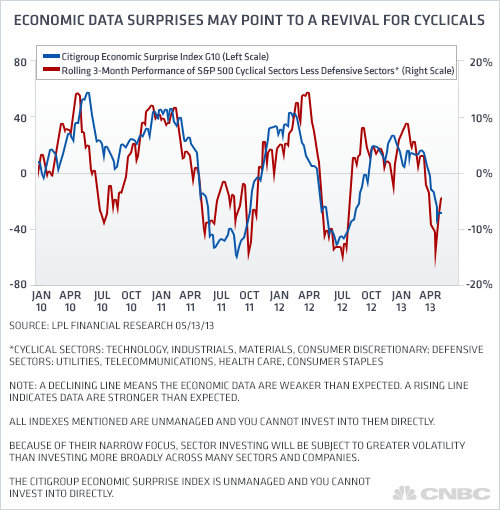"I think we've finally gotten economists' expectations low enough that we're in the bottoming process for that index," he said. Kleintop, who had been expecting a market correction, said some sectors have been correcting, and in the past several weeks, the previously lagging cyclical sectors have been pulling ahead.
"We could get another month or two or maybe three of the cyclicals leading this market. They're not tired yet," Kleintop said. "We could see this market higher if we get new leadership from cyclical stocks."
Kleintop said the normal behavior of the dollar has been to rise when investors looked for safe havens, but that's not the case now. "The fact the dollar goes up at the same time as stocks, that's a good sign. It may mean buyers are coming in from overseas to buy stocks. The individual investor doesn't appear to be buying this market," he said, adding companies are no longer buying back as much of their own stock since stock prices have risen.
"Corporate insiders appear to be selling at a record-breaking pace. who's buying the market? well we're seeing foreigners coming into the market." He said the market could still see a pullback, and this new correlation between markets could be temporary.
Yields have been rising since the April jobs report came in better than expected on May 3. They have moved another leg up since rumors circulated Thursday about a possible Wall Street Journal story about the Fed tapering back its $85 billion quantitative easing program. A story finally appeared that did say the Fed was considering its exit strategies, but it was the rumor that stoked yields.
Low yields had been driving investors to equities, but Ruskin said he found in a study back to 1973 that there were many times when the stock market was able to rise with the dollar. "I hesitate to use the word 'normal' because the correlations can shift around. The view of normality can shift around, but this would not be seen as particularly unusual behavior," Ruskin said.
"We're now in an environment where the market can smell the end of QE coming up, or at least a tapering," Ruskin said. "They can see a market where bond yields are higher." Ruskin said the markets would react more if they thought it were the end of zero interest rates.
What to Watch
Producer prices and the Empire State survey are released at 8:30 a.m., while industrial production and capacity utilization are released at 9:15 a.m. ET. The National Association of Home Builders survey is released at 10 a.m.
Earnings Wednesday are expected from Deere and Macy's before the open, and Cisco, Skechers and Youku after the close.




